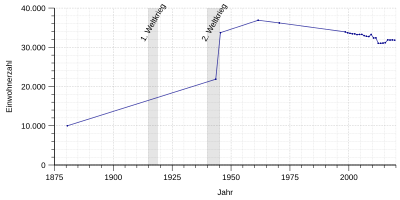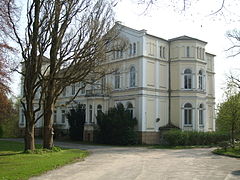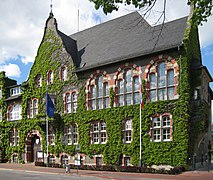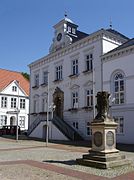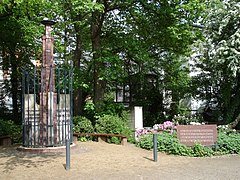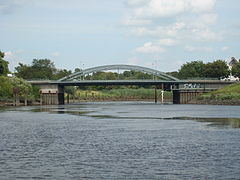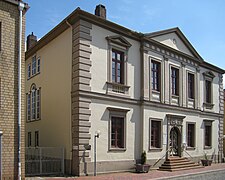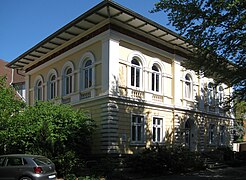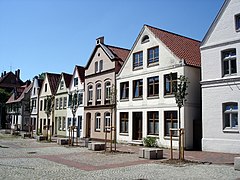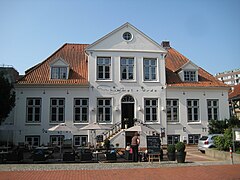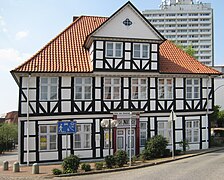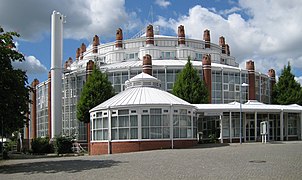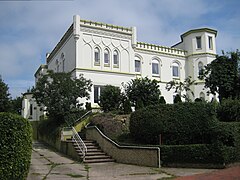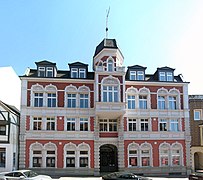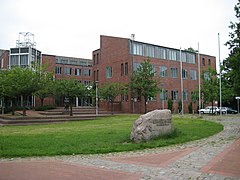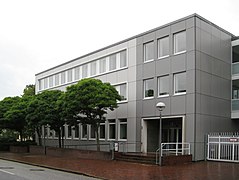Itzehoe
| coat of arms | Germany map | |
|---|---|---|

|
Coordinates: 53 ° 56 ' N , 9 ° 31' E |
|
| Basic data | ||
| State : | Schleswig-Holstein | |
| Circle : | Stone castle | |
| Height : | 22 m above sea level NHN | |
| Area : | 28.03 km 2 | |
| Residents: | 31,803 (Dec. 31, 2019) | |
| Population density : | 1135 inhabitants per km 2 | |
| Postal code : | 25524 | |
| Area code : | 04821 | |
| License plate : | IZ | |
| Community key : | 01 0 61 046 | |
| LOCODE : | DE ITZ | |
| City structure: | 9 districts | |
City administration address : |
Reichenstrasse 23 25524 Itzehoe |
|
| Website : | ||
| Mayor : | Andreas Koeppen ( SPD ) | |
| Location of the city of Itzehoe in the Steinburg district | ||
Itzehoe (pronounced [ ɪtsəˈhoː ] with Dehnungs-e , Low German : Itzhoe ) is a medium- sized town in southwest Schleswig-Holstein on both sides of the Stör . It is the capital of the Steinburg district and is one of the oldest cities in Holstein.
geography
Geographical location
The city lies directly on or on both sides of the Stör in a largely hilly and heavily wooded area. The part on the right side of the sturgeon lies on a compression moraine , which at the same time forms the boundary between Geest and Marsh . The part on the left-hand side of the Stör is partly on the Münsterdorfer Geestinsel . Downstream of the city, the Störmarsch widens to the right to Wilstermarsch and to the left to Krempermarsch . The city is part of the Hamburg metropolitan region .
The size of the urban area comprises a total of 2,803 ha (built-up areas 757 ha; streets, squares, bodies of water 371 ha; parks, green spaces, sports fields, cemeteries 216 ha; agricultural areas 763 ha; allotments 46 ha; forestry areas 650 ha).
Neighboring municipalities and surrounding cities
The city borders on the communities of Heiligenstedten , Oldendorf , Ottenbüttel , Schlotfeld , Oelixdorf , Münsterdorf , Breitenburg (with the district Nordoe), Kremperheide and Heiligenstedtenerkamp . The nearest towns are Wilster , Krempe and Kellinghusen ; the next larger cities Neumünster , Heide , Elmshorn and Hamburg .
climate
The climate is humid and maritime . The annual average temperature is 8.2 ° C (maximum temperature 28 ° C, minimum temperature −10 ° C), the amount of precipitation 860 mm.
history
Origin of the city name
Itzehoe was first mentioned in the 12th century as "Ekeho" by Saxo Grammaticus . 1196 wrote another mention "de Ezeho". The meaning of the name is still controversial today: One possibility would be “pasture land at the river bend” (Middle Low German “hô” for a flat raised promontory in a plain or a river meander , Middle Low German “ete” for pasture land). Today's Bach Itze is the name of a brook that was named after the city in the 20th century and not the other way around.
Development of a provincial town into the seat of the ducal meeting of estates
To protect against the Danish Vikings marauding from the north, the Esesfeldburg was built under Charlemagne in 810 AD in the Oldenburgskuhle , but it is not directly related to the development of Itzehoe. In their protection, Archbishop Ebo von Reims built a small monastery or prayer house, the "Cella Welana", in the summer of 823 in today's Münsterdorf , as a base for the Christian mission he initiated in Denmark . The larger Echeho Castle, built around 1000 in the nearby Störschleife, became the nucleus of a settlement which, benefited by the granting of the Luebian city charter (1238), combined with the exemption from duty , which at that time was only granted to Hamburg in the state, and later the stacking right ( 1260), developed into a trading town . Itzehoe was involved in the salt, cloth and grain trade during this time and was at times an important hub in European east-west trade. On the other side of the river, further settlements arose around the cloister courtyard (approx. 1260) and around the Laurentii church (first mentioned in 1196).
Under Gerhard von Holstein-Itzehoe , Itzehoe was also briefly the residence of the County of Holstein-Itzehoe in the 13th century .
Caused by this mixture of secular and ecclesiastical rule in Itzehoe there were four separate judicial districts (jurisdictions) in the city area from 1617 to March 31, 1861, each with its own gallows . A stone castle was built by the Counts of Schauenburg around 1180 on an old castle wall within the Störschleife . The medieval law of the castle applied. The associated Galgenberg is a Bronze Age burial mound between Struvestraße and the Ringstraße Galgenberg in the Wellenkamp district. The last public execution of the robbery murderer Johann Lau from Brokdorf took place there on December 18, 1856. In the merchant settlement (Neustadt) founded by Adolf IV von Schauenburg and Holstein in 1238 , the law of Luebi was in force . The gallows hill of the Lübschen city was a Bronze Age burial mound on Buchenweg east of the Lübschen fountain . Furthermore, the Cistercian convent founded in 1256 had its own law. During the Reformation in 1541, the monastery was converted into a noble evangelical women's monastery, which still exists today. The still existing monastery courtyard next to the St. Laurentii Church is also one of the oldest preserved areas in Itzehoe. The gallows hill of the monastery was the Germanic grave . Furthermore, in today's urban area there was still the rule of Breitenburg with its own rights. The gallows hill of the Breitenburg rule was on a hill northeast of the Kratt .
Medieval Itzehoe was divided into residential quarters. For a long time only craftsmen (gardeners, barrel makers) were allowed to live in the old town, merchants and other craftsmen had to settle in the new town, which was divided into four quarters, with the urban upper class concentrated in the two oldest quarters around the market.
During the Thirty Years' War the city was billeted and plundered several times, but there was no major destruction, as the city council handed over the city to General Wallenstein without a fight in 1627 . This enabled Itzehoe to maintain its status as fifth among the eighteen cities of Schleswig-Holstein.
After Itzehoe had been largely spared from wars for a long time, the city was almost completely destroyed by Swedish soldiers in 1657 in the Danish-Swedish War (1657–1658) . As a result, the cloister of the Laurentii Church is now the only preserved medieval building in Itzehoe.
In the 17th century Itzehoe was the seat of the ducal regiment on foot Prince Georg (around 1500 men) and in the 18th century three companies of the cuirassiers and the dragoons of the body regiment.
In 1712, the Asian bubonic plague that had been brought in from East Prussia and Poland broke out in Itzehoe . 250 inhabitants died as a result of the disease (around 7% of the then 3500 population).
Itzehoe was only indirectly affected by the Napoleonic Wars through transit and billeting as well as financial burdens. From 1807, Itzehoe briefly became the residence of Prince-Elector Wilhelm I of Hesse-Kassel, who had fled into exile from Napoléon .
Before the Schleswig-Holstein uprising , in which a large part of the citizenship of Itzehoe took part in the German-minded Schleswig-Holstein movement, the Holstein Assembly of Estates met in Itzehoe from 1835 to 1848 and later again from 1852 to 1863 , thereby establishing the History of parliamentarism in Schleswig-Holstein. After the German-Danish War , the Duchy of Holstein fell to Austria , whose governor Ludwig Karl Wilhelm von Gablenz finally convened the Holstein Assembly of Estates for the last time on June 11, 1866. However, a conference was prevented by the side effects of the German-German war . After the war, the Duchy of Holstein was including Itzehoe to Prussia: It was created in 1867 - together with the Duchy of Schleswig - the province of Schleswig-Holstein .
With the railway connection (1847) and the connection to the new Chaussee from Hamburg to Rendsburg (1846), the industrial age began in Itzehoe, so that in the 19th and later in the 20th century many commercial and industrial companies (including sugar production, weaving mills , Chemical industry and shipyard) settled in and around Itzehoe, which helped the city to regain greater economic importance.
Itzehoe as a Prussian garrison town and during the First World War
While the inhabitants of Holstein, and thus Itzehoe, were initially more part of the Augustenburg party , this changed noticeably after the establishment of the empire . The enthusiasm and admiration for Prussia increased in all parts of the population and several monuments in the city were dedicated to Prussia and its personalities. Among other things, a bronze statue of Kaiser Wilhelm I was erected in the city park in 1890 (melted down in World War II) and in October 1905 the founder of the empire, Otto von Bismarck, was particularly honored with the inauguration of the Bismarckian column in the city forest . This Bismarck tower is still one of the city's cultural monuments today .
After its foundation on July 29, 1866, Itzehoe became the seat of the Field Artillery Regiment General-Feldmarschall Graf Waldersee (Schleswigsches) No. 9. Furthermore, after the Franco-German War won during the founding period , Itzehoe experienced an economic boom. The population increased suddenly, the port flourished and several larger factories were built in the food and textile industries, soap and paper processing, as well as a few smaller engineering factories and other shipyards.
During the First World War Itzehoe was not directly affected by the military conflict, but suffered like many German cities from famine caused by the British naval blockade in the North Sea; many of the city's citizens did not return from the battlefields of Europe and the population fell sharply.
The city during the Weimar Republic and the Third Reich
As in the entire German Reich in 1918/1919, during the November Revolution , the rebel sailors and workers tried to usurp power. The officer corps tried to prevent the rebels from marching into the city by blocking the arterial roads from Itzehoe, but neglected to guard the station. 50 sailors reached the city this way, hoisted the red flag and formed a workers 'and soldiers' council.
During the Weimar Republic, Itzehoe's population grew from just under 18,000 to 20,000. In their voting behavior, they preferred the Social Democrats, the National Liberals and the German Nationals (as an example the result of the Reichstag election of December 7, 1924 : 12,713 voters in Itzehoe, votes SPD 3515, DVP 2228, DNVP 1935, DDP 1015, KP 933, Center 67) .
In the Reichstag election of March 5, 1933 , the last Reichstag election during the Nazi regime, in which several parties were allowed, the 14,788 eligible voters in Itzehoe elected the NSDAP with 6,161 votes , the SPD with 3,480 , the KPD in 1979 and the KPD with 1,054 DNVP, Center 84.
After Altona was spun off by the Greater Hamburg Act , the province of Schleswig-Holstein lost one of its four regional courts. From April 1, 1937, Itzehoe received its own regional court as a replacement. 13 local courts were initially assigned to this. While the number of local courts decreased over time, the area covered by the regional court has remained essentially unchanged since then.
After the beginning of the Second World War , many of Itzehoe's inhabitants joined the Wehrmacht and died in the course of the war. Compared to most of the northern German cities, the city itself hardly suffered from the aerial warfare. After October 1941, only nine bombs were dropped on Itzehoe. Itzehoe was not an important destination due to the lack of industry. On October 31, 1941, five bombs fell on Brunnenstieg and on a house in Sandberg, killing one citizen and injuring two other people. In mid-April 1945 a bomb fell near Poelstrasse in the middle of Lindenstrasse and damaged several houses on both sides of the street. Also in April 1945, the 10,000 m³ gas tank of the gas works in the Gasstrasse burned out after it had been bombed by British planes. On May 2, 1945, bombs hit the southwest of Sude around a mill construction company, killing 22 people. A second attack a few hours later hit the Brückenstraße / Liethberg triangle. In both cases there was complete destruction of buildings and major damage in the wider area.
From July 1943, parts of the population were evacuated from Kiel and Hamburg to Itzehoe because of the bombing raids. In addition, from 1944 onwards, many expellees came to the city from the eastern German regions . The number of inhabitants increased from 21,870 to 33,736.
During the Second World War there were several forced labor camps in Itzehoe : The Fuchsberg camp for the Siemen & Hinsch company with 150 people, the Schulenburg camp for the Alsensche Portland cement factory with 130 people, the Leuenkamp camp for the Hengstenberg sauerkohlfabrik, which has been located in Itzehoe since 1937, with 100 women and the camp of the Army Munitions Establishment with 135 people. In addition, in the former wallpaper factory on Feldschmiedekamp there was a military hospital for Belarusian armed forces and in the hall of the Hotel "Adler" there was a prisoner-of-war camp for French.
Itzehoe was the garrison location ( Wehrkreis X, Hamburg) of the 225th Infantry Division of the Wehrmacht, which was involved in the 1940 Vinkt massacre in Belgium.
At the end of the war, Germany was gradually occupied by the Allies. On May 4th, Hans-Georg von Friedeburg signed the surrender of all German troops in north-west Germany, the Netherlands and Denmark near Lüneburg on behalf of the last Reich President Karl Dönitz , who had previously left the last Reich government in Flensburg - Mürwik . British troops occupied Itzehoe on May 5, 1945. The war was over for Itzehoe.
After the Second World War
The British military government initiated denazification measures immediately after the war . The National Socialist emblems were removed from the city, National Socialist street and square names were renamed and National Socialists were removed from offices.
At the end of the war, the population of Itzehoe doubled due to refugees and displaced persons from East Prussia , Pomerania and Silesia , which, as in most towns in the British and American zones of occupation, led to a considerable housing shortage. This could only be reduced gradually with new buildings in the city, especially in the Tegelhörn district.
In 1946, on the initiative of the film producer Gyula Trebitsch , who had lived in Itzehoe for several years, the first memorial to the victims of National Socialism in Northern Germany was created in Itzehoe . The design came from the Hamburg architect Fritz Höger .
The British occupation troops were replaced by Norwegian troops in 1949 , which in turn were replaced by Danish occupation troops in 1950/1951 . Basically, Itzehoe remained under British occupation .
In the 1960s and 1970s, the first high-rise buildings were built in three districts of Itzehoe: the first on Marienburger Platz in Tegelhörn, the second on Lindenstrasse in Sude, and the third two in the city center. The Holstein Center stands between these two high-rise buildings : built in 1972, it is the largest shopping center in western Schleswig-Holstein and offers shops on two sales levels a total of over 14,000 m² of retail space. Various events take place there at irregular intervals. In 1997 the buildings were completely renovated and in 2002 attempts were made to revitalize them. A main entrance to the Holstein Center is located on the Feldschmiede pedestrian zone immediately adjacent to it . In 2017 the center was sold; it is largely empty and filed for bankruptcy in June 2020.
The new theater is located near the field forge (built on the bank of the filled-in Störschleife ). It was inaugurated in 1992. The old city theater burned down to the ground in 1994.
Another big fire was remembered for a long time. Adjacent to the train station was the 40,000 m² site of a timber wholesaler that fell victim to the flames in 1988. It was only thanks to the favorable wind conditions on that day that the fire did not spread to the buildings in the city center and the train station. The extinguishing work lasted almost a whole day.
Until it was filled with around 110,000 m³ of sand in 1974, the Störschleife had a decisive influence on the image of Itzehoe's inner city. The loop was the original course of the river. The Stördurchstich (Lower German: " Delf ", from which the names "Delftor" and "Delftorbrücke" of the city exit and the Störbrücke come from) made Itzehoe's castle an island. It is said that there were sluices in Delf that closed when the water ran out, forcing the disturbance loop to flow through and clean it. After their removal, the sturgeon loop increasingly silted up and developed into an almost stagnant, foul-smelling body of water. The old town center, the "new town", could only be reached via bridges. In the course of the redevelopment of the "New Town", during which almost all the houses on this former island were demolished and replaced by new buildings and new streets laid out, this defining element of the city died out. Only a few artificially created water basins between the new theater and the Salzstrasse are reminiscent of the original course of the loop. Adenauerallee, one of Itzehoe's main thoroughfares, now runs along the former western section. Due to these renovation and development measures, Itzehoe "won" second place behind Idar-Oberstein in a 1988 "competition for the most consistent disfigurement of a historical townscape" carried out by German town planners , where in the 1980s the Nahe river running through the urban valley area on one Length of two kilometers had been built over with a road.
In order to improve the cityscape again, an initiative was launched in 2011 with the aim of promoting the reopening of the filled in Störschleife in the center of Itzehoe. In 2017, the entire city center was declared a redevelopment area. The goal was expressly to restore the disturbance loop.
Itzehoe achieved sad nationwide notoriety in March 2014 when a gas explosion in Schützenstrasse in the southeast of the city devastated the entire street and completely destroyed the house with number 3. Four people were killed in the accident; 15 people were injured, some seriously. The accident happened during dredging work on the sewer system when an unrecorded gas pipe was hit. The excavator driver and the foreman were held responsible for the accident and had to answer in court, where they were acquitted. In February 2017, civil proceedings began to clarify liability for damages.
In mid-March 2018 there were attacks on Turkish mosques and shops across Germany . In Itzehoe, too, windows of the mosque were smashed and a fire started. People were not harmed.
Population development
- 1803: 4.325
- 1835: 5.595
- 1840: 5,636
- 1845: 5.932
- 1855: 6,691
- 1880: approx. 10,000
- 1919: 18,658
- 1925: 19,637
- 1930: 21,709
- 1933: 20.906
- 1943: 21,870
- 1945: 33.736
- 1961: 36,897, 36 of which are from the area incorporated in 1976
- 1970: 36,208, 32 of which are from the area incorporated in 1976
- 1998: 33,926
- 1999: 33.710
- 2000: 33,549
- 2001: 33,442
- 2002: 33,429
- 2003: 33.230
- 2004: 33.277
- 2005: 33.285
- 2006: 32,982
- 2007: 32,800
- 2008: 32,732
- 2009: 33.271
- 2010: 32,368
- 2011: 32,405
- 2012: 31,009
- 2013: 31,013
- 2014: 31,065
- 2015: 31,163
- 2016: 31,896
- 2017: 31,848
- 2018: 31,879
politics
Itzehoe belongs to the Bundestag constituency Steinburg - Dithmarschen Süd and the Landtag constituency Steinburg-Ost , both of which were won directly by the CDU in the last election. The city is the administrative seat of the Steinburg district .
City structure and incorporations
Itzehoe is divided historically in the districts of Old Town and New Town (the old town is the starting point of the settlement, in the New Town was first town charter; together they form the city center), the south to the sturgeon Wellenkamp , Sude ( incorporated 1911), Kratt ( umgemeindet 1911 ), Pünstorf (formerly an independent village, then an estate; only settled again in the 20th century), Tegelhörn (only settled in the 20th century), Edendorf (incorporated in 1963), Sude-West (expanded through reunification, in the 1960 / 70s built-up area) and monastery forest on the site of the former Hanseatic barracks (development since 1995).
On January 1, 1976, an area of the municipality of Oelixdorf with then about 30 inhabitants was incorporated into the city of Itzehoe.
coat of arms
Blazon : “In red over blue waves on a continuous silver wall, two pointed silver tin towers with a closed gate; a silver nettle leaf between the tower roofs. "
Council meeting
Result of the local elections on May 6, 2018:
| Political party | be right | percent | Seats |
|---|---|---|---|
| CDU | 3,054 | 31.5% | 13 |
| SPD | 2.120 | 21.9% | 9 |
| Alliance 90 / The Greens | 1,705 | 17.6% | 7th |
| FDP | 792 | 8.2% | 3 |
| DAFi - The alternative faction itzehoe | 606 | 6.3% | 2 |
| The left | 570 | 5.9% | 2 |
| Independent constituency of Itzehoe (UWI) | 521 | 5.4% | 2 |
| Itzehoer Citizens Forum - IBF | 313 | 3.2% | 1 |
| Turnout: 37.7% |
mayor
Due to the six-year electoral term of the previous mayor, Rüdiger Blaschke, which ended on April 14, 2010, a new mayor was elected on March 7, 2010 with a voter turnout of 36.39%. The following parts of the vote were accounted for by the candidates:
- Rüdiger Blaschke (independent): 39.33%
- Andreas Koeppen (SPD): 56.08%
- Martin Wnuk (Pensioners' Party): 4.59%
Thus, Andreas Koeppen was elected as the new mayor of Itzehoe in the first ballot.
Former mayor of the city
1st Mayor 1535–1801
- 1535 to after 1558: Jürgen Elers
- after 1558 to before 1567: Hans Hasenkroch
- before 1567 to 1568: Hans Rottmann
- 1568 to after 1571: Jochin Elers
- after 1571 to 1584: Andreas Gottfriedt
- 1584–1598: Hans Danckwart
- 1598–1603: Gerhard Spanhake
- 1603 to after 1622: Arnold Eilbracht
- after 1622 to 1627: Hartwig Mohr (fled from the advancing Swedish troops to Hamburg in 1627)
- 1627–1630: Hinricus Wasmer (1588–1643), ancestor of the builders of the Wasmer-Palais and Karl Friedrich Lucian Samwer
- 1630–1631: Peter Michelsen
- 1631–1653: Ericus Moritz
- 1653–1666: Johannes Woldenberg
- 1666–1667: Philippus Berger
- 1667–1681: Johann Poppe
- 1681–1683: Gabriel Hasse
- 1683–1693: Detlef Steinmann
- 1693–1699: Hermann Schmiedling
- 1699–1725: Georg Pflueg
- 1725–1731: Detlef Bilenberg (Bielenberg)
- 1731–1769: Albert Elers
- 1769–1801: Christian Wilhelm Töpfer
Mayor 1801–1911
- 1801–1815: Andreas Ernst Löhmann
- 1815–1837: Detlef Heinrich Rötger
- 1837–1849 (1852): Friedrich Johann Heinrich Rötger (resigned in 1849, Danish confirmation only in 1852)
- 1849–1852: Georg Ferdinand Lüders (acting)
- 1852–1868: Gustav Poel (was granted the city's first honorary citizenship on July 9, 1868)
- 1868–1870: Wilhelm Koch (acting)
- 1870–1879: Eugen Dohrn
- 1879–1882: Carl Julius Stemann
- 1882–1911: Christoph Steinbrück
1st Mayor 1912–1919
- 1912-1919: Bruno Salomon
Mayor from 1920 until today
- 1920–1933: Adolf Rohde , DVP
- 1933–1934: Hermann Nappe , NSDAP
- 1934–1940: Herbert Heitmann , NSDAP
- 1940–1945: Kurt Petersen , NSDAP
- 1945: Karl Niese , temporarily employed by the British military government as a non-party member
- 1945: Helmuth Delbrück , temporarily deployed as a non-party member of the British military government
- 1945–1947: Carl-Christian Arfsten , CDU
- 1947–1949: Carl Stein , FDP
- 1949–1950: Georg Krumm , FDP
- 1950–1966: Joachim Schulz , independent
- 1967–1990: Günter Hörnlein , non-party
- 1991-2002: Harald Brommer , SPD
- 2002–2010: Rüdiger Blaschke , independent, proposed for election in 2002 by the CDU, with election recommendation by the FDP
- since 2010: Andreas Koeppen , SPD, with election recommendations from the CDU, SPD, IBF, UWI and the Greens
Town twinning
Town twinning has existed since 1982 with Cirencester in Great Britain, since 1988 with the French municipality of La Couronne in the Charente department and since 1990 with Pasłęk (Prussian Holland) in Poland . There has also been a friendship between cities with Malchin ( Mecklenburg-Western Pomerania ) since 1990.
Culture and sights
- Public buildings and facilities
The memorial for the victims of the Nazi regime at the current location
Buildings
- Germanic grave from the Bronze Age (around 1500 BC), excavated in 1937 on the Galgenberg
- Remains of the disused cement works of Alsen AG , today a playground for graffiti artists , see Planet Alsen
- Historic town hall: oldest part from 1695.
- Monastery courtyard : remnants of the Cistercian monastery founded in 1256, official name: Itzehoe noble monastery. After the Reformation, a noble women's monastery under the protection of the Schleswig-Holstein knighthood
- Prinzesshof : Founded in the 16th century, changes in the 17th and 18th centuries. Century. Today the oldest secular building in the city and a district museum since 1988
- St. Jürgen Chapel : Baroque half-timbered building. Originally the collegiate chapel of St. George's Hospital with interesting ceiling paintings
- City Church of St. Laurentii
- Nagelsche half-timbered houses , Sandberg 47, double -gabled half-timbered house , the hallway with old beams, stairs with double railing, oriels as a relic from the time when there was a restaurant there (18th century).
- "Wesselburg" in the Breitenburger Straße, a villa built in 1873 by Heinrich Wessel in the Moorish style
- the Westerhof with the villa built by Charles de Vos
Museums
- Wenzel Hablik Museum
- Kreismuseum Prinzeßhof
- Störewer "Hermann" (meanwhile transferred to the port museum of the city of Hamburg )
theatre
Theater has been played in Itzehoe for over a hundred years; since September 1992 in the new theater itzehoe . It was designed by Gottfried Böhm and built at a cost of around 20 million euros. Between 570 and 1100 seats - depending on the seating. The oval, circus tent-like construction favors the multifunctionality of the theater.
The palette ranges from spoken and musical theater to ballet, dance theater, cabaret, pantomime and shows to chamber and symphony concerts. In addition, there is children's and youth theater as well as the possibility of holding congresses, meetings, seminars, trade fairs and the like. to keep ä., make the distinctive construction of community center . In 2017 the theater was recognized as a cultural monument .
In August 2009 the theater itzehoe acted as a “recording studio” for the Chinese pianist Lang Lang , who recorded his new CD there.
- Other structural sights
leisure
- Itzehoer swimming center (indoor and outdoor pools)
- CineMotion (cinema)
- Stör (canoe and rowing area)
- House of home
- Kulturhof
- Forest nature trails
- Cycling and riding region
- library
- Haus der Jugend / HDJ (youth club under supervision / care of adults)
- Computer Club Itzehoe eV
Sports
- Itzehoer SV
- Itzehoer Störlauf
- Sport fishing club (SAV) and the surrounding area e. V.
The association has several bodies of water under lease in Itzehoe: Small and large Tonkuhle fishing waters , Edendorfer Tonkuhle as well as part of the sturgeon and the Malzmüllerwiesenteich as rearing waters . - Itzehoer Tennisverein e. V.
- Itzehoe Eagles Basketball e. V. (2nd basketball Bundesliga Pro B)
- Itzehoer Kanu Club e. V.
- Itzehoer Rowing Club from 1966 e. V.
- Itzehoer Wasser-Wanderer e. V.
- Sailing Association Itzehoe e. V.
- Itzehoe sports club
- Diving club Actinia e. V.
- Itzehoer Hockey Club e. V.
Divisions: Hockey, tennis and archery - SV Wellenkamp Itzehoe e. V.
- Itzehoer Sportkegler e. V.
- Box-Club Itzehoe from 1950 e. V.
nature
Woods
There are various forests in and around Itzehoe. In the northeast these are the Itzehoer Klosterforst (forest property of the Itzehoe monastery ), the Lübsche wood (forest property of the city of Itzehoe) and the Schmabek district forest (forest property of the Steinburg district). Surrounded by urban development are the front wood belonging to the monastery forest and the Lehmwohld, which was formerly connected to it, as well as the Hackstruck, which was once also connected to the forest areas (all three also owned by the monastery). The latter is to be further cleared in favor of a further expansion of the Itzehoe Clinic . The Heiligenstedtener Holz (private forest property of the Wiese family) adjoins the north-western border of Itzehoe; on the eastern border of the Breitenburger forest (private forest property of the Rantzau family ). In the south on the Münsterdorfer Geestinsel to the left of the Stör, Itzehoe borders on forests in which the Nordoer inland dunes and sinkholes such as the Knickenkuhle are also located.
Protected areas
Protected as a landscape protection area are the Twiedtberge and its surroundings, the Stormsteich and its surroundings, the wooded areas of Vorderholz, Lehmwohld and Hackstruck and the Heiligenstedtener Holz, which is partially located in Itzehoe. So far there are no nature reserves in Itzehoe. For several years, however, a corresponding designation of the Stormsteich and its surroundings has been considered.
Nature experience space
The Itzequelle nature experience area is located on the eastern edge of the front wood of the monastery forest .
Citizens' decision of March 17, 2019
On March 17, 2019 were in Itzehoe a referendum on the question of whether a former allotment site location as a development area or a "natural landscape area with orchard should be expelled." The opponents of the building area won the referendum.
Economy and Infrastructure
- Further infrastructure facilities
Former economic situation
Up until the first decades after the Second World War, Itzehoe's economy was shaped by the cement works and the inland port, as well as its former function as a garrison town . Natural resources such as clay, sand and gravel are largely exploited ( Große Tonkuhle , Kleine Tonkuhle, Edendorfer Tonkuhle , Koch's sand and gravel pits ). Today characterize industry - ruins , such as the Planet Alsen , the former industrial area. However, the site is currently being redeveloped; residential and commercial areas are to be created directly on the Stör.
Today's economic structure
According to a study by the University of Cologne, Itzehoe created the best climate for company start-ups in Germany in 2007. The Fraunhofer Institute for Silicon Technology (ISIT) and the Society for Technology Promotion Itzehoe mbH (IZET Innovation Center Itzehoe) are one of the most important economic factors in the entire region. In connection with this, several high-tech companies have settled in and around Itzehoe.
Itzehoe also developed into a central shopping town on the west coast of Schleswig-Holstein between Elmshorn and Husum . A long pedestrian zone extends between Dithmarscher Platz and the “Long Bridge” for about one kilometer. Many smaller and larger specialist retailers, service providers and restaurateurs are based there, but the vacancy rate is now around 20%. This development is partly attributed to the loss of the Hertie department store in 2009, which, together with the large “Holstein Center” shopping center, acted as the “powerhouse” of the pedestrian zone. Overall, however, the number of companies has remained roughly the same in recent years. At the Malzmüllerwiesen there is also a weekly market twice a week . Various commercial areas in the outskirts offer extensive other ranges such as B. two hardware stores , a large electrical retailer and several supermarkets .
The numerous retirement and nursing homes and the Itzehoe Clinic have also become important employers. Itzehoer Versicherungen and the pump factory Flowserve SIHI are among the largest companies in the city . The Alliance Healthcare Germany (formerly Andreae-Noris Zahn / ANZAG ), the cement manufacturer Holcim and the plants of the pharmaceutical manufacturer Pohl-Boskamp have locations near the city.
One of the largest employers, the Prinovis gravure printing company of the Arvato , Gruner + Jahr and Axel Springer media groups , ceased operations in April 2014.
Water supply
Itzehoe's drinking water supply is ensured by the wells of the Tonkuhle and Twietberge waterworks, both of which are operated by Stadtwerke Itzehoe GmbH. In 2004 around 2,100,000 m³ of water were released.
Medical supplies
The Steinburg district has a medical center, 4 specialist clinics, 42 care facilities, 164 doctors, 65 dentists and 34 veterinarians, many of which are based in Itzehoe (as of 2015).
traffic
Road traffic
Itzehoe is connected to the federal motorway network by the A 23 .
The B 5 also connects Brunsbüttel and Wilster with Itzehoe and the B 77 leads in the direction of Schleswig and Rendsburg . In addition, the B 206 creates connections to the east to Hohenlockstedt, Kellinghusen, Bad Segeberg and Lübeck.
Hamburg can be reached in 50 km / 35 minutes, Kiel in 80 km / 60 minutes and Heide in 48 km / 30 minutes.
Bicycle traffic
In the last measurement in 2011, bicycle traffic accounted for 13 percent of the traffic in Itzehoe. The master plan adopted by the city in 2014 aims to increase bicycle traffic to 20 percent by 2025 and a reduction in environmental pollution. The measures include creating continuous bicycle axes from the periphery to the center of Itzehoe, improving the path system, completing the parking system and targeted marketing.
Itzehoe is also connected to some tourist long-distance cycle routes, including the Ochsenweg and the Mönchsweg .
Rail transport
The Itzehoe railway station is on the railway line Hamburg-Westerland ( Marschbahn ), which is electrified to Itzehoe. This station is served by both the private railway company Nordbahn and the regional railway Schleswig-Holstein . InterCity trains operated by Deutsche Bahn AG also stop in Itzehoe.
Traffic on the Itzehoe section of the Itzehoe – Wrist railway was discontinued at the end of 1994.
See also: List of InterCity train stations
Maritime transport
Itzehoe is located on the federal waterway Stör with direct access to the Elbe and has its own city port with a quay length of 450 m today. In the past u drove from here. a. Whalers to Greenland . Today the port is suitable for both sea and inland vessels. The modern port facility enables goods to be handled quickly with an average throughput of 100 tons per hour for bulk goods.
Public facilities
Judiciary
- Courthouse
Itzehoe several judicial authorities are situated. These include district court Itzehoe , Landgericht Itzehoe and the prosecutor at the District Court and the Social Court Itzehoe .
The Itzehoe correctional facility is also the oldest and smallest correctional facility in Schleswig-Holstein.
schools
Itzehoe has all the usual forms of school education in Schleswig-Holstein. In addition to 14 kindergartens, there are the following general education schools: (number of pupils from the 2019/2020 school year)
-
Funding Centers (FöZ)
- FöZ Pestalozzi-Schule (FöZ learning), Schulstraße, 9 students in 1 class, 242 supervised
- FöZ Steinburg School (FöZ Intellectual Development), Einhardstrasse, 155 students in 17 classes, 5 supervised
-
Primary schools (GS)
- GS Edendorf, Obere Dorfstrasse, 245 students in 11 classes
- GS Sude-West, Ansgarstraße, 188 students in 8 classes
- GS Wellenkamp, Kamper Weg, 207 students in 10 classes
- Ernst-Moritz-Arndt-School, Schäferkoppel, 214 students in 9 classes
- Fehrs-Schule, Fehrsstraße, 333 students in 14 classes
- Julianka School, Julianka, 126 students in 6 classes
-
Community schools (GemS)
- GemS am Lehmwohld, Am Lehmwohld, 556 students in 22 classes
- Klosterhof Community School, behind the Klosterhof, 440 students in 17 classes
- Wolfgang-Borchert-Schule (RegS and GemS), Gorch-Fock-Straße, 583 students in 24 classes
- Free Waldorf School (elementary and community school with upper level and FöZ part), Am Kählerhof, 352 students in 13 classes, 16 supervised
-
High schools
- Auguste Viktoria-Schule , Große Paaschburg, 931 students in 38 classes
- Kaiser-Karl-Schule , Hinter dem Sandberg, 774 students in 32 classes
- Sophie-Scholl-Gymnasium , Am Lehmwohld, 687 students in 31 classes
-
Former schools
- Lübscher Kamp Community School (closed at the end of the 2016/2017 school year)
- Neumann Commercial College, Sandberg, (1954–2019)
The Sude-West primary school maintains a school friendship with the German School in Brunde (Rothenkrug) in North Schleswig. This goes back to the 1950s when the municipal high schools (AVS and KKS) collected funds for the local school.
There is also the regional vocational training center of the Steinburg district (Juliengardeweg, 3425 students in 201 classes), several private educational institutions such as the Kulturhof Itzehoe and the adult education center in the Georg-Löck-Haus. It was named after Georg Löck (1782-1858), a political reformer and liberal , to whom a memorial was placed in front of the old town hall.
Churches and ecclesiastical institutions
- Evangelical Lutheran
- St. Ansgar, Wilhelmstrasse
- Dietrich Bonhoeffer Community, Schauenburgstrasse
- St. Jacobi, Viertkoppel
- St. Jürgen, St. Jürgen-Strasse
- St. Laurentii, Kirchenstrasse
- St. Michaelis, Struvestraße
- St. Thomas, Albert-Schweitzer-Ring
- Community in the Protestant Church, behind the monastery courtyard
- Evangelical-Free Church
- Evangelical Free Church Congregation (GfC Congregation for Christ), Sandkuhle
- Community on Sandberg, Sandberg
- Roman Catholic
- Church of Christ the King, Parish of St. Ansgar, Hindenburgstrasse
- Other denominations
- New Apostolic Church, Liliencronstrasse
- Adventist Church, Seven-Day Adventists, Allensteiner Weg
- Day care centers
- ev.-luth. KiTa Edendorf, Albert-Schweitzer-Ring
- ev.-luth. KiTa Fehrsstraße
- ev.-luth. KiTa Juliengardeweg
- ev.-luth. KiTa Tegelhörn, Viertkoppel
- ev.-luth. KiTa Wellenkamp, Sanddeich
- Roman Catholic KiTa St. Ansgar, Coriansberg
- graveyards
- Brunnenstrasse cemetery
- Sandberg Forest Cemetery
Personalities
sons and daughters of the town
In alphabetic order
- Bruno Adler (1896–1954), Bishop of the German Christians
- Peter Heinrich Althöfer (1775–1841), pastor and main preacher in Nortorf
- Helga Anton (1923–2007), writer
- Karl Armbrust (1867–1928), painter
- Oswald Beling (1625–1646), officer, Virgil translator
- Else Berkmann (1904–2001), politician (SPD), member of the state parliament (Baden-Württemberg)
- Olaf Berner (* 1949), teacher and handball player
- Udo Bielenberg (* 1938), civil engineer and Low German author .
- Antje Blumenthal (* 1947), politician (CDU), member of the Bundestag
- Hans Bongers (1898–1981), 1st Executive Board member, Lufthansa AG
- Johannes Brandes (1467–1531), Roman Catholic clergyman, dean of the cathedral in Lübeck
- Kim-Sarah Brandts (* 1983), actress
- Walter Bröcker (1902–1992), philosopher
- Cay von Brockdorff (1874–1946), philosopher
- Johann Dietrich Busch (1700–1753), organ builder
- Johann Daniel Busch (1735–1787), organ builder
- Sven Butenschön (* 1976), ice hockey player
- Caramelle (* 1988), R&B / pop singer
- Lambert Daniel Carstens (1690–1744), organ builder
- Kurt Claasen (1908–?), SS-Hauptsturmführer
- Bruno Claussen (1884–1945), State Secretary in the Reich Ministry of Labor
- Margot Claussen (1885–1968), painter
- Doris Decker , actually Doris Sünkenberg (* 1963), saxophonist, singer and lyricist
- Rainer Dopp (* 1948), politician, State Secretary in the Ministry of Justice (Mecklenburg-Western Pomerania)
- Christian von Eggers (1758–1813), lawyer, chief procurator at the German law firm and chief president of the city of Kiel
- Werner Fabricius (1633–1679), organist and composer
- Rudolf Focke (1852–1918), librarian and university professor in Poznan
- Uta Fölster (* 1956), President of the Schleswig-Holstein Higher Regional Court
- Gerd Frähmcke (* 1950), athlete
- HG Francis (1936-2011), writer
- Alfred Franzke (1896 – after 1950), politician (SPD), member of the Landtag (Schleswig-Holstein)
- Max Frauböse (1892–1966), politician (CDU), member of the Landtag (Schleswig-Holstein)
- Thomas Gerull (* 1962), fencer, winner of the Olympic silver medal
- Karen Gloy (* 1941), philosopher
- Carl Julian von Graba (1799–1874), royal counselor and researcher on the Faroe Islands
- Hans Otto Gravert (1928–2015), animal breeding scientist and university professor.
- Kurt Gudewill (1911–1995), musicologist
- Erich Hagenah (1898–1984), politician (SPD), member of the Landtag (Schleswig-Holstein)
- Toke Constantin Hebbeln (* 1978), film director
- Johann Karl Heide (1897–1974), politician (SPD), member of the Bundestag
- Peter Heeren (* 1965), composer
- Mark Helfrich (* 1978), politician (CDU), Member of the Bundestag
- Helvig von Holstein (around 1257 – between 1324 and 1326), Queen of Sweden
- Cornelius Hölk (1869–1944), professor of didactics
- Anja Jacobs (* 1974), director
- Matthias Jarren (1872–1960), painter
- Johann Adolph Kielmann von Kielmannsegg (1612–1676), advisor to Duke Christian Albrecht of Schleswig-Holstein-Gottorf, Canon of Schleswig and provost of the St. John's Monastery
- Nicolaus Anton Johann Kirchhof (1725–1800), Senator of the Free and Hanseatic City of Hamburg
- Matthias Köhne (* 1966), politician (SPD), mayor of the Berlin district of Pankow
- Levin Kurio (* 1977), comic artist
- Beata Lehmann (* 1965), actress
- Wilhelm von Levetzau (1820–1888), Prussian District Administrator Stormarn
- Volker Liepelt (* 1948), politician (CDU), member of the House of Representatives, State Secretary for Economics and Technology (Berlin)
- Otto von Linstow (1842–1916), Prussian medical officer, zoologist
- Max Volkert Martens (* 1948), actor
- Erich Mauritius (1631–1691), lawyer
- Bernhard Mohrhagen (1814–1877), painter
- Otto von Moltke (1847–1928), politician (German Reich Party), member of the Reichstag
- Ludwig Müller (1729–1818), painter and gilder
- Traute Müller (* 1950), politician (SPD), member of the Hamburg Parliament
- Bernhard Oelreich (1626–1686), theologian, court preacher to the Danish king, superintendent of Bremen
- Heiger Ostertag (* 1953), historian
- Armin Pahlke (*?), Judge at the Federal Fiscal Court
- Hendrik Pekeler (* 1991), handball player
- Wolfgang Poel (1841–1926), judge
- Jens Priewe (* 1947), journalist
- Yok Quetschenpaua (* 1962), singer
- Horst Raecke (1906–1941), politician (NSDAP), member of the Reichstag, Bremen State Council, SS leader and SA brigade leader
- Peter Rau (* 1940), librarian and classical philologist
- Britta Reimers (* 1971), politician (FDP), member of the European Parliament
- Hans Rickers (1899–1979), landscape painter
- Jochen Roggenbock (* 1947), politician (SPD), member of the state parliament (Schleswig-Holstein)
- Philip Rüping (* 1984), show jumper
- Christian Levin Sander (1756–1819), poet
- Ingo Schachtschneider (* 1959), politician (DVU / DLVH), member of the state parliament (Schleswig-Holstein)
- Karl-Emil Schade (1927–2007), pastor and Bible translator
- Torge Schmidt (* 1988), politician (Pirate Party), member of the Landtag (Schleswig-Holstein)
- Eberhard Schmidt-Elsaeßer (* 1955), politician (SPD), State Secretary in the Ministry of Justice and Equality (Saxony-Anhalt)
- Thorsten Schütt (* 1963), sculptor
- Jakob Heinrich Hermann Schwartz (1821–1890), doctor
- Hans Siebke (* 1922), civil engineer
- Sabine Sinjen (1942–1995), actress
- Robert Sloman (1812–1900), shipowner and politician (National Liberal Party), member of the Reichstag of the North German Confederation
- Johann Steffens (around 1560–1616), composer and organist
- Wilhelm Struve (1901–1982), politician (NSDAP), member of the Reichstag
- Mike Süsser (* 1971), cook
- Martin Teising (* 1951), psychiatrist
- Lisa Tomaschewsky (* 1988), actress
- Philipp Vogler (* 1965), pianist, composer, conductor, university professor
- Gerd Voss (1907–1934), lawyer and SA storm leader
- Georg Wegemann (1876–1961), geographer
- Theodor Werner (1884–1973), politician (SPD), member of the Landtag (Schleswig-Holstein)
- Heinrich Wessel (1838–1905), entrepreneur in the cement industry
- Joachim Irgens von Westerwich (1611–1675), wholesale merchant and landowner
- Anni Wadle (1909–2002), communist and resistance fighter against National Socialism
- Rainer Wicklmayr (1929–2020), politician (CDU), member of the Landtag (Saarland), Deputy Prime Minister and Minister of the Interior (Saarland)
- Eliza Wille (1809-1893), writer.
- Adolph Wittmaack (1878–1957), businessman and writer
- Wolfgang Wodarg (* 1947), politician (SPD), member of the Bundestag
- Arthur Zachger (1898–1969), photographer and photo journalist
Other personalities
- Dietrich Austermann (* 1941), lawyer, politician, Minister for Economic Affairs of Schleswig-Holstein a. D.
- Wilhelm Beseler (1806–1884), politician (member of the German-minded Schleswig-Holstein movement / casino parliamentary group), member of the Schleswig Assembly of Estates, member and vice-president of the Frankfurt National Assembly for the constituency of Itzehoe, president and governor of the provisional government of Schleswig- Holstein from 1848 to 1851
- Fabian Boll (* 1979), soccer player, played in the youth and later in the men's area at Itzehoer SV
- Bazon Brock (* 1936), emeritus professor for aesthetics and cultural mediation, artist and art theorist, student of the Kaiser Karl School
- Otto Eisenmann (1913–2002), politician (DP, FDP, CDU), mayor, Minister of Social Affairs in Schleswig-Holstein
- Wenzel Hablik (1881–1934), painter, graphic artist and craftsman
- Elisabeth Hablik-Lindemann (1879–1960), picture weaver and master weaver
- Juliane zu Hessen-Kassel (1773–1860), princess of the house of Hessen-Kassel and abbess of the noble monastery of Itzehoe
- Wilhelm I of Hessen-Kassel (1743–1821), Landgrave and Elector of Hessen-Kassel
- Gerhard von Holstein-Itzehoe (1232-1290), Count of Holstein-Itzehoe
- Uwe Jens Jensen (1941–1997), dramaturge, author, theater director at the Burgtheater Vienna, pupil of the Kaiser Karl School
- Karl Detlev Jessen (1872–1919), German-American professor of German studies, Harvard University (from 1900) and Bryn Mawr College (from 1910), attended the community school and the secondary school in Itzehoe
- Gisela Kühler-Balcke (1913–1983), sculptor
- Georg Löck (1782–1858), politician (National Liberal ), member of the Holstein Estates Assembly for Itzehoe
- Helmuth Karl Bernhard Graf von Moltke (1800–1891), Field Marshal General, politician (German Reich Party), member of the Reichstag
- Otto Müller (1893–1955), SPD politician, member of the city council and deputy mayor
- Lucius Carl von Neergaard (1797–1881), politician (member of the German-minded Schleswig-Holstein movement), member and vice-president of the Holstein assembly of estates, member of the Frankfurt National Assembly for the constituency of Itzehoe
- Malte Rühmann (1960–2008), composer, pianist, organist, pupil at the district high school
- Rudolf Schönbeck (1919–2003), football player - former goalkeeper at Itzehoer SV; Goalkeeper at the 1952 Olympics
- Thomas Selle (1599–1663), teacher, composer, church musician a. a. at the St. Laurentii Church
- Otto Siemen (1881–1966), inventor and manufacturer
- Dorothea Louise zu Sonderburg-Augustenburg (1663–1721), princess from the house of (Schleswig-Holstein-) Sonderburg-Augustenburg and abbess of the noble monastery of Itzehoe
- DJ Tomekk and Lil 'Kim sing in the top ten hit Kimnotyze (2001): "From Karlsruhe to Itzehoe: / You take it to the extreme, you./ Give it to me right, no matter where!"
- Käthe Riechers (1906–1964), welfare worker and co-founder of the Itzehoer AWO after the Second World War
Honorary citizen
- Gustav Poel , mayor, honorary citizen since 1868
- Charles Pierre von de Vos (the elder), member of the city council (1870/1871), founder of the de Vos sugar factory and honorary citizen since 1878
- Carl Hirschberg , founder of the Hirschberg oil and soap factory, honorary citizen since 1892
- Alfred von Waldersee , Field Marshal General, honorary citizen since 1902
- Johann Hinrich Fehrs (1838–1916), narrator in Low German, honorary citizen since 1913
- Charles Rudolph von de Vos (the younger), member of the city council (1897/1903), manufacturer of the de Vos sugar factory, honorary citizen since 1919
- Lucian Alsen , manufacturer of the Alsen Portland cement factory, honorary citizen since 1961
Fictional literary characters
- Long Peter from Itzehö , figure from Wallenstein's camp by Friedrich Schiller
- Herr Kloßen from Itzehoe , figure from Die Vollidioten by Eckhard Henscheid
- Teacher couple from Itzehoe , figures from head births by Günter Grass
literature
- Carl Friedrich Jägermann: Itzehoe and its surroundings in historical and topographical terms , Itzehoe 1819 (2nd edition Itzehoe 1838).
- Reimer Hansen : History of the city of Itzehoe. Itzehoe 1910.
- Detlef Detlefsen : The beginnings of Itzehoe , in: ZSHG 40 (1910), pp. 325–337 with notes from Reimer Hansen, pp. 337–339.
- Marianne Hofmann: The beginnings of the cities of Itzehoe, Wilster and Krempe , in: ZSHG 83 (1959), pp. 15–82 (Part I) and ZSHG 84 (1960), pp. 15–92 (Part II).
- Rudolf Irmisch : History of the city of Itzehoe. Itzehoe 1960.
- Heinz Longerich: Itzehoe . Publishing house Peter Gerbers, Itzehoe 1977.
- Rudolf Krohn : Walks through Alt-Itzehoe. Hansen and Hansen, Münsterdorf 1981, ISBN 3-87980-221-1 .
- City of Itzehoe (Ed.): Itzehoe. History of a city in Schleswig-Holstein. 2 vol., Itzehoe 1988 and 1991, DNB 945685769 .
- Herbert Karting: Itzehoer Schifffahrtschronik: The maritime history of the city and its port, its merchants, skippers, ship owners, shipbuilders and their vehicles to the present day (with 536 partly historical images), Edition Falkenberg 2015, ISBN 3954940523 , 9783954940523, many pages available at Google Books .
Web links
Footnotes and individual references
- ↑ North Statistics Office - Population of the municipalities in Schleswig-Holstein 4th quarter 2019 (XLSX file) (update based on the 2011 census) ( help on this ).
- ↑ The place name can be found in the 14th book of the Gesta Danorum . There it says: cui cum occursum suum ob vetera odia onustum magis quam gratum sentiret, ut iram obsequiis flecteret, apud Ekeho oppidum suis eum impensis excipere statuit ( Dan 14.28.6 )
- ↑ Itzehoe and its surroundings (PDF file; 2.87 MB), Section 3.1.1.
- ↑ Mechanische Netzfabrik und Weberei (1873, “largest network factory in continental Europe”), in Itzehoer Schiffahrtschronik , pp. 155–157. at Google Books
- ↑ bismarckturm-itzehoe.de
- ^ Reimer Möller: A coastal region in political and social upheaval (1860-1933). P. 195 ff.
- ↑ a b gonschior.de
- ↑ The Bomber's Baedeker
- ^ Hengstenberg in Itzehoe
- ^ The National Socialist Camp System (CCP). Edited by Martin Weinmann. Zweiausendeins Verlag, Frankfurt 1990, pp. 75f.
- ↑ The surrender on the Timeloberg (PDF, 16 S .; 455 kB)
- ^ City of Itzehoe. Itzehoe then ... 1930-1960. accessed on May 31, 2017.
- ^ City of Itzehoe. Itzehoe then ... 1930-1960. accessed on May 31, 2017.
- ↑ Retail in Itzehoe: New HC: Customers are in demand.
- ↑ Big gap in HC: Farewell after 15 years.
- ↑ Bankruptcy in the Holstein Center
- ↑ Cf. Dagmar Vorbeck, in: Stadt Itzehoe (Hrsg.): Itzehoe. History of a city in Schleswig-Holstein. Vol. II, p. 390.
- ↑ Homepage of the association “Störauf e. V. " ( Memento from April 26, 2017 in the Internet Archive )
- ↑ Itzehoe: Now it is being renovated - until 2032.
- ↑ Norddeutsche Rundschau: Schützenstrasse: Gas explosion with four dead. October 30, 2015
- ↑ Fatal gas explosion: construction workers acquitted.
- ↑ After the gas explosion in 2014: Who pays for the damage?
- ↑ Attacks on Turkish institutions in Germany - The air tastes of ashes.
- ^ City of Itzehoe: History of a city in Schleswig-Holstein from 1814 to the present, Volume 2, page 26
- ^ City of Itzehoe: History of a city in Schleswig-Holstein from 1814 to the present, Volume 2, page 279
- ^ Itzehoe from 1930-1960
- ↑ a b c Federal Statistical Office (ed.): Historical municipality directory for the Federal Republic of Germany. Name, border and key number changes in municipalities, counties and administrative districts from May 27, 1970 to December 31, 1982 . W. Kohlhammer, Stuttgart / Mainz 1983, ISBN 3-17-003263-1 , p. 186 .
- ↑ with second homes
- ^ A b Itzehoe: Economy / location information
- ↑ Schleswig-Holstein's municipal coat of arms
- ^ City of Itzehoe - municipal elections on May 6, 2018 / May 27, 2018
- ↑ Gustav Poel on familiepoel.de
- ^ Wesselburg in Itzehoe ( Memento from March 5, 2016 in the Internet Archive )
- ↑ Theater Itzehoe: Furious opener in cultural monument.
- ^ Website of the Itzehoer Ruder Club eV
- ↑ Website of the Itzehoer Wasser-Wanderer e. V.
- ↑ Council meeting passes second referendum
- ↑ Voting result referendum
- ↑ Itzehoe - "Between Sea and Metropolis" (status 2007) ( Memento from February 25, 2007 in the Internet Archive )
- ↑ shz.de
- ↑ welt.de
- ↑ itzehoe.de ( Memento from October 19, 2013 in the Internet Archive )
- ↑ itzehoe.de ( Memento from October 19, 2013 in the Internet Archive )
- ↑ Prinovis printing works closes plant ( Memento from March 10, 2014 in the Internet Archive )
- ↑ shz.de "Mourning and Pride: The Last Shift at Prinovis"
- ↑ Figures for the 2004 financial year of Stadtwerke Itzehoe ( Memento from August 2, 2007 in the Internet Archive )
- ↑ Location information as of 2015 ( Memento from August 15, 2015 in the Internet Archive )
- ↑ ( Page no longer available , search in web archives: Itzehoe - Die Stadt an der Stör ) (PDF file; 122 kB)
- ↑ SCREEN - Active Media - screen.de // IOSTREAM.de: Masterplan Fahrradverkehr - Itzehoe.de. Accessed June 24, 2017 (German).
- ↑ SCREEN - Active Media - screen.de // IOSTREAM.de: Cycling & Hiking - Itzehoe.de. Accessed June 24, 2017 (German).
- ↑ shz.de of September 25, 2008.
- ↑ Statistical Office for Hamburg and Schleswig-Holstein: Directory of general education schools in Schleswig-Holstein 2019/2020
- ↑ see individual references in the biography article on the journalist Ilona B. Benda , his first wife






